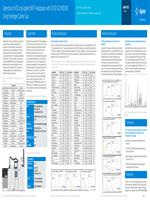 Online Monitoring of Particulate Matter (PM2.5) Using Thermal Desorption and GC–TOF MS
Online Monitoring of Particulate Matter (PM2.5) Using Thermal Desorption and GC–TOF MSAir Monitoring, Methods, and Technology
Oral Presentation
Presented by N. Boegelsack
Prepared by L. McGregor1, M. Edwards2, H. Calder3, J. Ogden1, B. Green1
1 - SepSolve Analytical, Unit 4, Swan Court, Forder Way, Hampton, PETERBOROUGH, England, PE78GX, United Kingdom
2 - SepSolve Analytical, 826 King Street North, Waterloo, Ontario, N2J 4G8, Canada
3 - Markes International, 1000B Central Park, Western Avenue, Bridgend, CF31 3RT, United Kingdom
Contact Information: [email protected]; 01733669222
ABSTRACT
The issue of urban air quality has received increased attention in recent years due to increased awareness of the potential health risks associated with particulate matter (PM). Airborne particles with diameters <2.5 μm (so-called PM2.5) are of most concern, as long-term exposure is thought to have the biggest impact on public health.
PM2.5 consists of wide-ranging compounds from both primary emissions and secondary reaction, and drastic changes in environmental air quality during the COVID-19 pandemic mean it is now more important than ever to have accurate chemical fingerprinting and reliable source attribution.
PM2.5 is typically trapped onto quartz fibre filters and the semi-volatile organic compounds (SVOCs) are solvent extracted in a multi-step process prior to GC-MS analysis. However, sample preparation is time-consuming and the potential for error increases at each stage. In addition, solvent extraction dilutes the sample and waste disposal becomes an environmental concern in its own right.
Such limitations have led global research organisations to search for improved workflows. Here, we describe a novel analytical platform for online monitoring of PM2.5, using a modified thermal desorber coupled with gas chromatography and time-of-flight mass spectrometry (TD-GC-TOF MS). This system offers a solution to the time-consuming sample preparation and environmental concerns associated with the analysis of PM2.5, while providing simple, yet sensitive, chemical fingerprinting.

